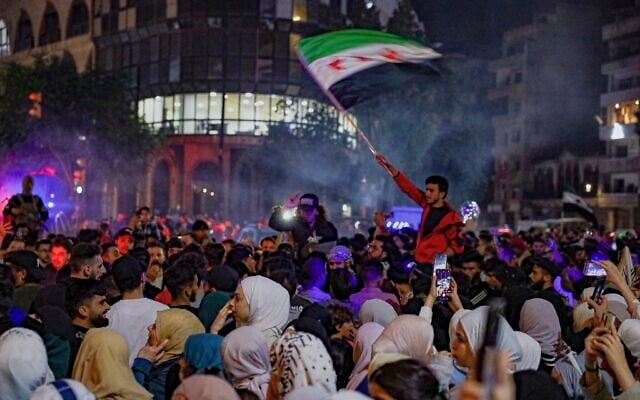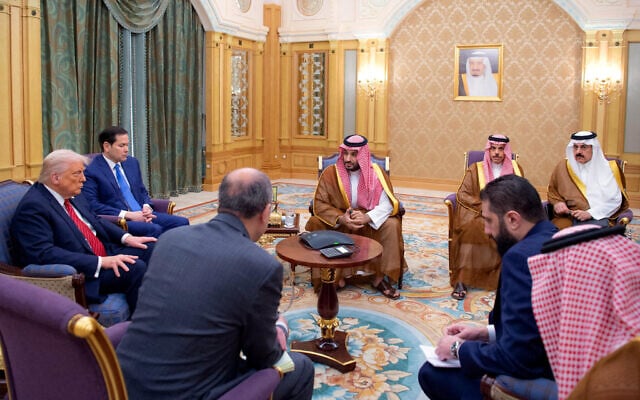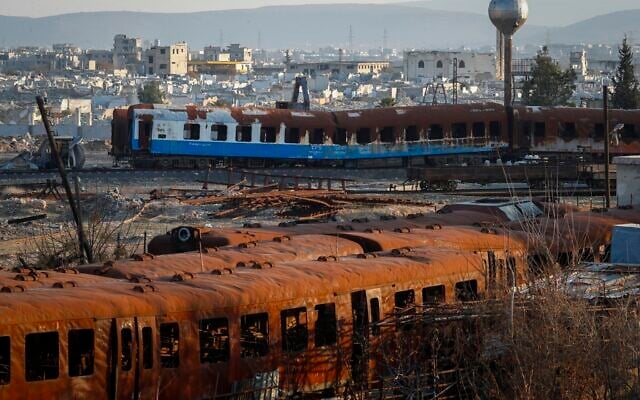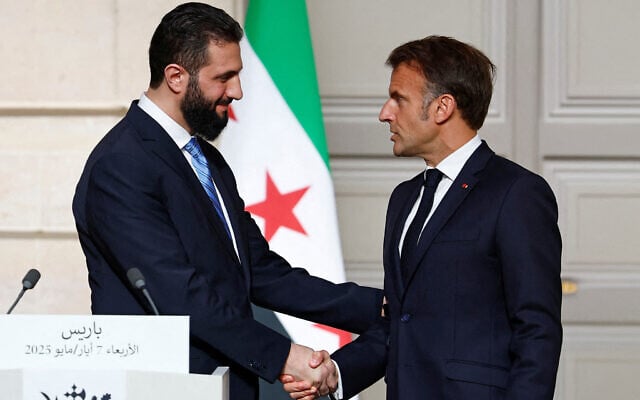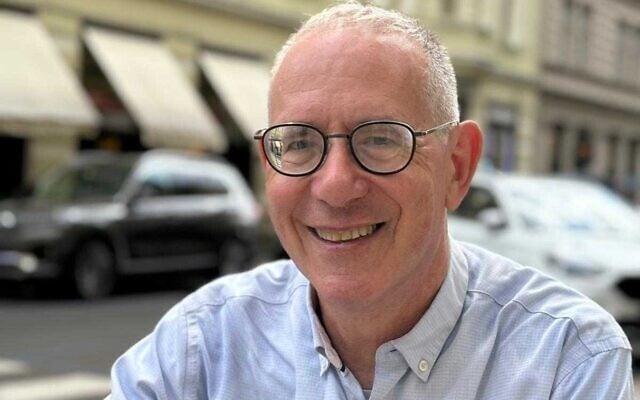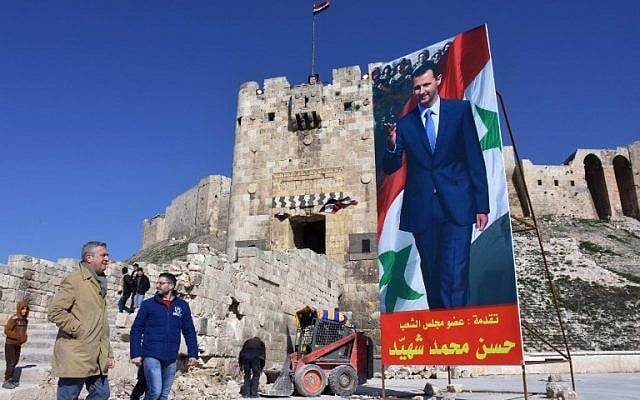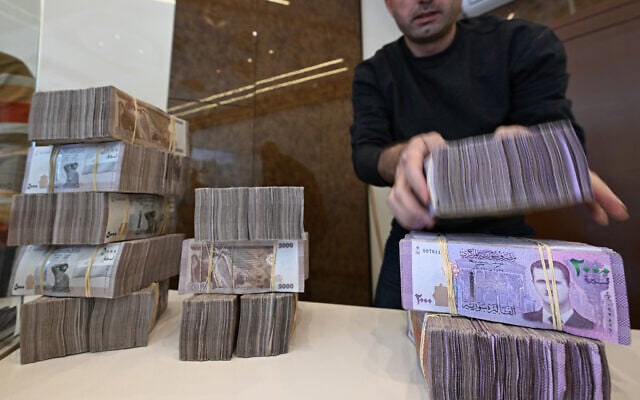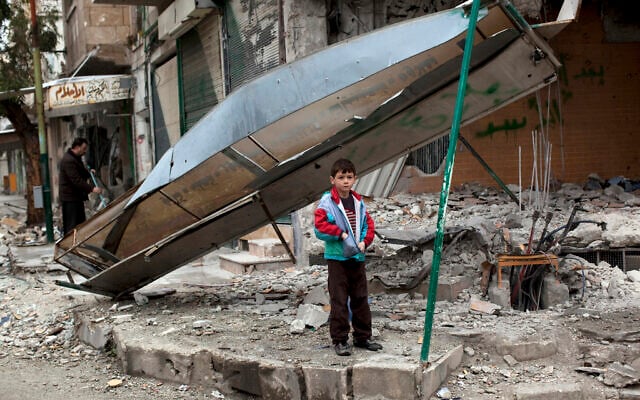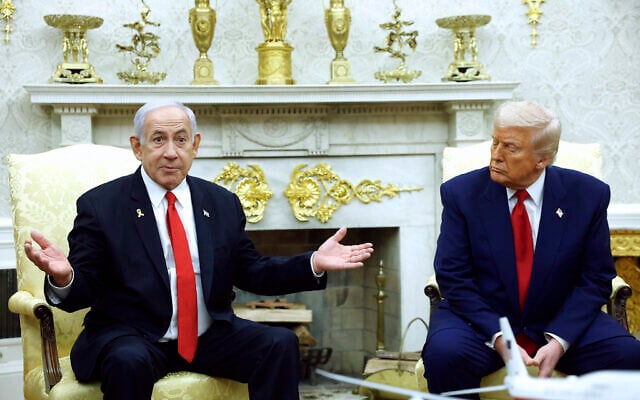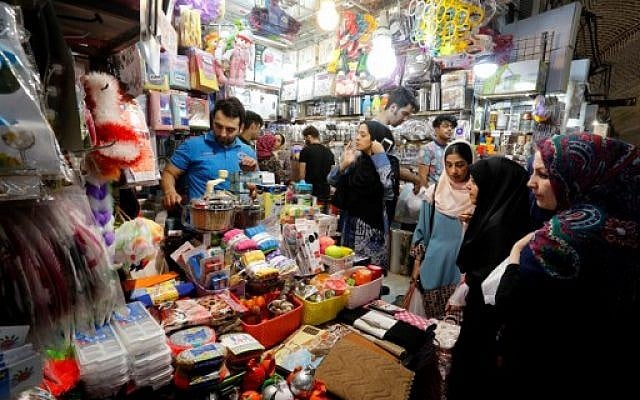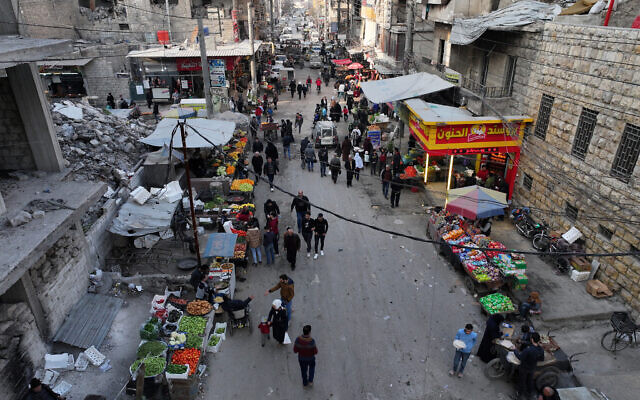


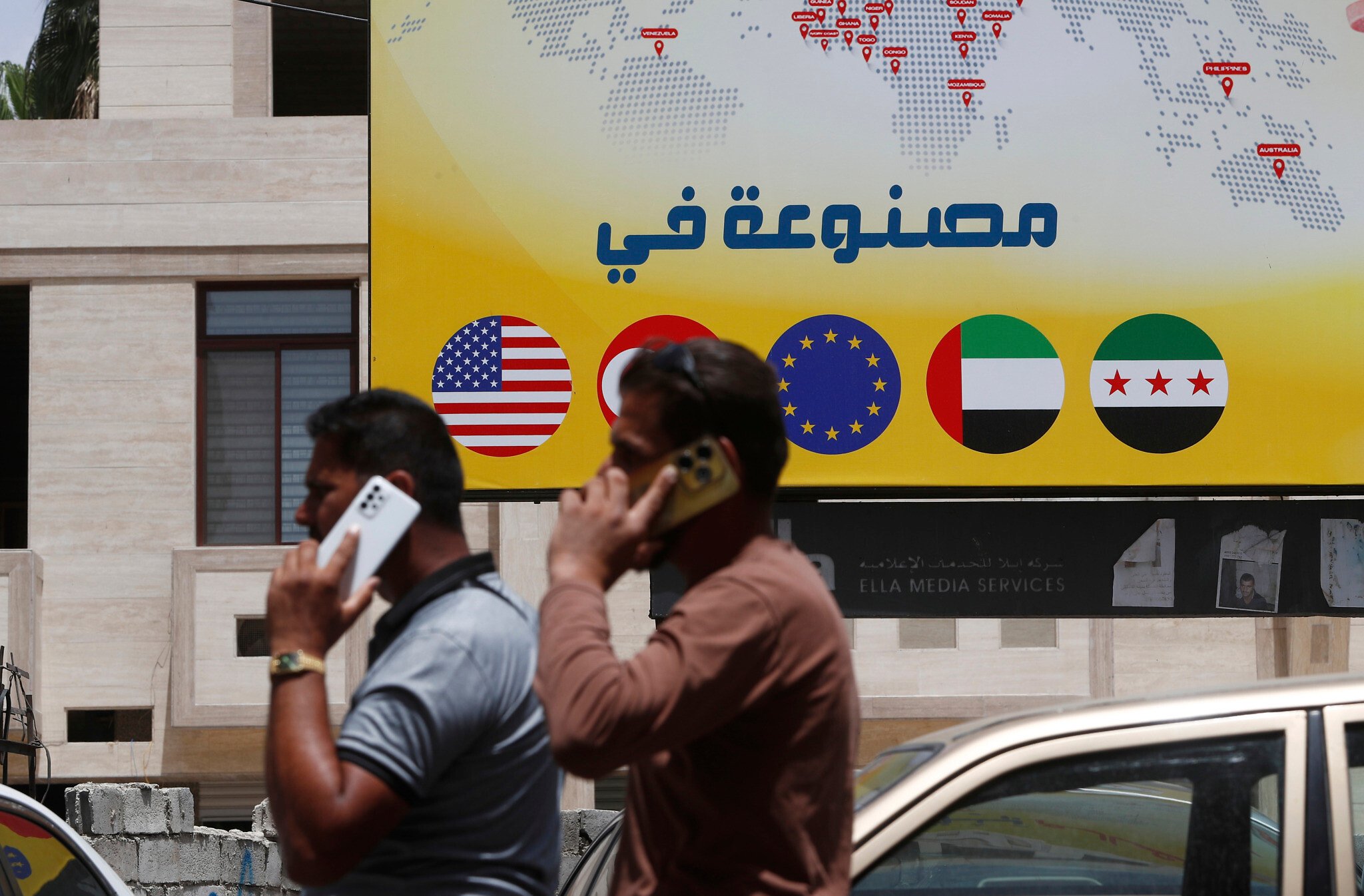
On the evening of May 13, Syrians across the battle-scarred country erupted in celebration. After 14 years of disastrous civil war, thousands took to the streets in a rare expression of public jubilation to exult in the surest sign yet that their nation was on the road to recovery and reintegration into the international community, even as some remained wary of the jihadist government now in charge.
Just a short time earlier, US President Donald Trump, visiting Saudi Arabia on the first major foreign trip of his second presidency, had announced his intention to lift all American sanctions on Syria.
Earlier in the day, Trump had met with interim Syrian President Ahmed al-Sharaa, marking the first public meeting between the countries’ leaders since Bill Clinton met Hafez al-Assad in March 2000.
“There is a new government that will hopefully succeed in stabilizing the country and keeping peace,” Trump said in Riyadh. “That’s what we want to see in Syria. I will be ordering the cessation of sanctions on Syria.”
In a televised address later that evening, Sharaa called the move a “historic and courageous decision that will end our people’s suffering.”
Though no official action has yet been taken to implement the policy, others in the US and around the world have similarly praised the move as a major step that will help stabilize the region and invigorate Syria’s economic prospects after years of suppression under a punishing international sanctions regime.
South of the Syrian border, though, some in Israel have viewed the move with more circumspection, bemoaning the loss of a key lever that could have lured in another potential regional ally.
There also remains an undercurrent of unease regarding the new leadership given its jihadist roots, even as Sharaa renounces his jihadi past and opens his doors wide open toward the West.
The US has maintained a complex sanctions regime on Syria for decades, designating the country a state sponsor of terrorism in 1979. In 2004, president George W. Bush’s administration imposed measures targeting individuals and entities with close ties to the regime of then-president Bashar al-Assad.
Further sanctions were imposed by president Barack Obama’s administration in 2011, including the freezing of assets held in the US and a ban on Syrian oil imports, a critical source of revenue for the Syrian government. Those measures were imposed in response to alleged human rights violations at the onset of the civil war in February of that year.
The most consequential sanction in recent years has been the implementation of the Caesar Syria Civilian Protection Act. The law was passed by Congress in 2020 during Donald Trump’s first term in response to documented war crimes committed by the Assad regime during the civil war, but was only implemented under US president Joe Biden in 2022.
The Caesar Act imposed heavy financial penalties on virtually any foreign entity conducting business with Damascus, including Syrian officials and businesspeople.
Unlike previous penalties, the introduction of sweeping secondary sanctions deterred international donors and investors from engaging with Syria, leaving only Iran, Russia, North Korea, and their ilk as possible investment partners.
For Syria’s new leadership, which is desperate for external capital to jumpstart the economy while also seeking to move away from Iran and closer to the West, lifting the Caesar Act is critical.
In 2018, the United Nations estimated that Syria’s full reconstruction would require at least $250 billion, a sum that will be impossible to finance without access to international capital.
“This is a very significant development,” said Prof. Eyal Zisser, a leading Syria expert at Tel Aviv University. “The American sanctions have been a major obstacle to the inflow of funds and investment. No one wanted to risk investing, building, or buying a factory in Syria if it meant violating US sanctions.”
The lifting of sanctions goes hand in hand with a shift in tone from the international community, particularly the Gulf states and some European countries, which have expressed openness to reengagement with Syria.
Since leading the ouster of Assad in early December, Sharaa has made several official visits to the Gulf. Earlier this month, he flew to France to meet with French President Emmanuel Macron.
Key regional players began stepping in even before the formal US announcement on lifting sanctions, signaling growing confidence in the new regime’s stability and legitimacy, and laying the groundwork for future engagement.
In April, Qatar and Saudi Arabia pledged to pay off Syria’s $15 million debt to the World Bank, enabling the country to resume international borrowing, a promise they made good on last week. And on May 7, Syria’s finance minister announced that Qatar would provide $87 million over the next three months to cover public sector salaries.
“If sanctions had been lifted during Bashar al-Assad’s rule amid the civil war, it likely wouldn’t have had the same impact,” Zisser said. “Fewer countries had the resources or the willingness to invest. Today, there’s a government perceived as stable, with no immediate threat to its survival, and it enjoys backing from both Gulf states and European countries. Combined with the suspension of sanctions, this creates the conditions for money to start flowing into Syria,” he said.
Still, legal hurdles remain. Repealing the Caesar Act will require congressional authorization — a complicated and time-consuming process in Washington. Trump could suspend the law through an executive waiver, but it would be subject to renewal every 180 days, which could dent investor confidence. As of now, the act remains in place.
Syria’s economy, already fragile before the outbreak of war, has been left devastated by over a decade of brutal conflict. In 2009, Syria ranked 122nd globally in gross domestic product per capita at just $2,570 annually per person, according to international data covering approximately 200 countries.
When Assad assumed power from his father, Hafez, in 2000, his government introduced a series of economic reforms. The moves, praised at the time by institutions such as the International Monetary Fund, were credited with boosting private investment and spurring a measure of economic growth.
Despite modest progress, by the end of the decade, the country was still seen as underdeveloped and overly agrarian for a modern economy. The oil sector continued to dominate Syria’s exports, accounting for nearly half of all outbound trade, and economic activity was heavily concentrated in just two cities — Damascus and Aleppo — underlining stark economic disparities between urban centers and the countryside.
The civil war then decimated the economy. Mass unemployment, the displacement of millions, and the collapse of key export sectors due to sanctions, instability, and infrastructural damage plunged the country into fiscal freefall.
Between 2011 and 2014, GDP per capita in Syria dropped to just $600 annually, far below even the Gaza Strip and Lebanon.
In the later years of the war, Assad was thought to rely heavily on proceeds from the production and sale of Captagon, a powerful and dangerous amphetamine that reportedly generated Syria up to $5 billion annually.
In Assad’s final year in power, the Syrian pound collapsed by around 140%, and annual inflation soared to 100%. Recent estimates from the International Committee of the Red Cross and UNICEF indicate that between 70% and 90% of Syrians lived below the poverty line, with approximately 25% enduring conditions of extreme poverty.
“Syria is a shattered country after 15 years,” Zisser said. “Recovery will be a long process. But this is a light at the end of the tunnel — it gives hope for the people, and for the regime. It’s broke, so every dollar counts.”
Sharaa, citing Islamic prohibitions, has declared an end to the sale of narcotics and instead aims to revitalize Syria’s economy through expanded oil and gas exports and the development of other sectors.
According to Zisser, lifting sanctions and allowing the economy to be rebuilt could play a crucial role in stabilizing the regime. He noted that extreme rural poverty had been a factor in sparking the civil war.
“There were years of severe drought in the country, which led to the collapse of agriculture,” he said. “As a result, the hardest-hit regions became the starting point of the uprising against Assad’s regime. This wasn’t the sole cause, but it was the immediate trigger.”
“When something begins to generate income, some people benefit, then others follow – and gradually, support for the regime increases,” Zisser added.
In general, political stability in neighboring countries is viewed positively by Israel, which has a long-term interest in regional calm and stability within Syria. The Syrian civil war created fertile ground for the rise of extremist elements, which, in the absence of central authority, seized territory and accumulated power, threatening Israel and fueling global terror, such as the Islamic State.
Nonetheless, Prime Minister Benjamin Netanyahu lobbied Trump to keep the sanctions in place when he visited the White House last month, according to an Israeli official quoted by the Associated Press.
Publicly, Israeli authorities have not issued any official comment on the US intention to lift sanctions on Syria. This could reflect a wait-and-see approach or skepticism toward the new Syrian regime.
Sharaa previously led Hay’at Tahrir al-Sham, an Islamist terror group once affiliated with al-Qaeda. Regime officials were involved in several violent incidents, some of them severe, targeting minority groups in the country — most notably a massacre of the Alawite minority.
Israel has taken direct action against the regime to protect Druze when they were targeted as well, and warned that it could go further. Defense Minister Israel Katz has described al-Sharaa as a “jihadist terrorist from the al-Qaeda school who commits atrocities against civilians.”
Policy-makers had also viewed the prospect of lifting sanctions as a key bargaining chip that could have been used to help secure a long-elusive normalization pact between Israel and Syria as part of the Abraham Accords, a lever that Trump instead gave away for free.
According to the White House, Trump urged Sharaa to join the Abraham Accords during their meeting.
Even before then, Syria officially confirmed on May 7 that indirect talks with Israel were taking place, reportedly “to prevent loss of control” in the region.
No official updates on the talks have been provided by either side since, but if Israel and Syria do move closer together, Israeli business could benefit from the lifting of sanctions.
According to Israel’s Kan public broadcaster, senior figures in Damascus recently approached Israeli entrepreneurs to encourage Israeli investment in Syria. The group of official representatives and businesspeople said they were interested in “laying the groundwork for Israeli-Syrian business infrastructure,” the report said.
Historical parallels suggest that lifting international sanctions, even partially, can produce significant economic gains quickly. Iran’s experience following the 2015 nuclear deal provides a case in point.
After the international community lifted its heavy sanctions regime in exchange for caps on enrichment in January 2016, Iran witnessed a brief economic boom: GDP grew by 13.4% between 2016 and 2017, and oil exports to Europe surged from 10% to 36%.
However, that growth was short-lived. In May 2018, the Trump administration withdrew from the pact and reimposed sanctions. By 2020, Iran’s oil exports had plummeted to under 400,000 barrels per day – down from over 2.5 million in 2017 – and its GDP had fallen to half of its 2017 level.
A 2017 study by Israel’s INSS noted that Iran faced internal structural barriers such as high unemployment, currency instability, and bureaucratic inefficiencies even during the sanctions-free period. Moreover, its reputation as a state sponsor of terrorism continued to deter investors.
Iran’s case underscores a key lesson: sustained recovery requires the removal of sanctions and a welcoming investment climate free of internal and international obstacles.
Early signals from the new regime in Syria are cautiously encouraging in that regard. Reuters reported in December 2024 that Syrian officials have communicated to business leaders their intention to pursue a free-market policy based on open competition. That vision would position Syria alongside Gulf nations like Saudi Arabia, combining Islamic values with Western-oriented economic models.
“This is not going to be a socialist regime – they’re moving toward a capitalist model, like in Saudi Arabia,” said Zisser. “That suits Syria’s interests. It’s an Islamic state model that is also open to the West economically. In that sense, there’s no contradiction.”

